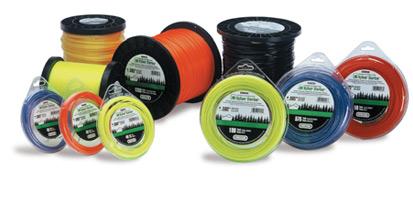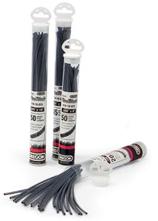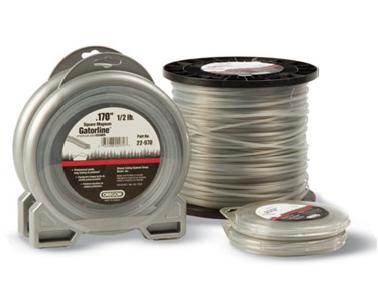Why Read This Article?
Finish Nailer Repair - Replacing the Driver Guide (Ridgid Part # 79004001022)
Article Breakdown
Finish Nailer Repair - Replacing the Driver Guide (Ridgid Part # 79004001022)
Choosing the right kind of trimmer line should also be decided by the type of trimmer being used, because most trimmers and trimmer heads will only accept a given range of line styles or sizes.
 Naturally, as the thickness and toughness of yard or garden material being cut increases, a heavier, sharper stlye of trimmer line is needed. We point out the major qualities that affect a trimmer line's cutting power and durability below, and discuss guidelines for matching trimmer line to its trimmer and its work.
Naturally, as the thickness and toughness of yard or garden material being cut increases, a heavier, sharper stlye of trimmer line is needed. We point out the major qualities that affect a trimmer line's cutting power and durability below, and discuss guidelines for matching trimmer line to its trimmer and its work.
Trimmer Line Buying Guide Chart
| Pre-Cut Line | Spooled Line | |
| Light to Medium Work | .065" 5-Sided Line .08" Round Line | |
| Medium to Heavy Work | .095" Square Line .099" Serrated Line | .095" 5-Sided Line .105" Square Line |
| Very Heavy Work | .130" Square Line .168" Serrated Line | .130" Twisted Line .170" Square Line |
Line Installation Method
The first step in selecting the right trimmer line is to make sure that it is compatible with your trimmer. Trimmer owners should find what kind of line their tool can accept by checking their user manuals.
Really, compatibility will be determined by the kind of trimmer head being used. So if your trimmer has a head other than its original, you'll want to refer to what kinds of trimmer line the new head can accept.
The biggest distinction between power trimmer and brush cutter designs that will affect cutting line compatibility is the kind of installation method the trimmer is designed for.
Fixed head trimmer designs use pre-cut trimmer string, while bump feed and twist feed systems use spooled cutting line.
Pre-cut Trimmer Line-
Instead of a long length of line being spooled around the trimmer's head, as in other systems, pre-cut line systems use individual lengths of line.

The benefit of these systems is that changing the line is fast and simple. However, users will find themselves stopping to change the line often if they mis-gauge the needed durability.
Spooled Trimmer Line-
Most trimmers use spooled trimmer line that is wrapped around the trimmer head. Although reloading this kind of line can be tricky for some trimmer owners, many trimmer designs are available that make reloading faster and easier.

The advantage to this kind of line installation system is that advancing the trimmer line is easy once it's reloaded, as with bump and automatic feed trimmers.
[Back to top]
Trimmer Line Shapes
Trimmer lines also come in different shapes, but the shapes aren't just for looks. Trimmer line shapes change how efficiently a trimmer cuts and how it cuts.
Generally, the most common trimmer line shapes are round, twist, square, 5-point (star), 6-point, and so on.
It's best to think of all these trimmer string shapes as fitting into two categories:
1. round and twisted, and
2. all the others that have edges (square, 5-point, etc.)
Round trimmer line is the most standard type and the most commonly used, but it tends to tear grass more than other types because it lacks cutting edges.
Twisted trimmer line is an improvement upon standard round line. The twisted shape gives twisted trimmer line a bit of an edge in comparison to round.
Trimmer line shapes that have edges are sharper. The edges that square and 5-point trimmer lines have allow the lines to actually slice through grass and weeds.
Serrated trimmer line has sharp peaks along its edges like a saw or kitchen knife, exposing more cutting surface for extra cutting power.
Some manufacturers make line with six, seven, even eight sides. The idea is that more edges create more cutting power. It's best for users to try a few and use what works for them.
It's important to note that using line that has more cutting power (edges) can sometimes take a trimmer user off guard. The cutting edges can make the line "grab" vegetation a little more than round and twisted line. That grabbing action can actually pull the trimmer down toward the ground, so users should be prepared to offer additional resistance.
[Back to top]
Trimmer Line Diameter
Trimmer line diameter is pretty straight-forward: the heavier the application, the thicker the diameter.
Not only will a larger diameter increase the cutting power of the line, it will also increase its durability against thicker grasses, weeds, and brush.
Each trimmer or trimmer head will normally only accept a specific range of line diameters, so it's best to check the user manual before setting out to buy replacement string for the first time.
Most trimmer line for grass trimmers and brush cutters is made in a range of 0.065 in. to 0.170 in. Here are some application guidelines for trimmer line diameter:
For light-medium work: 0.065 in. - 0.085 in.
For medium-heavy work: 0.085 in. - 0.110 in.
For very heavy work: 0.110 in.+
Light-medium work includes just grass cutting, medium-heavy work includes grass and small weeds, and very heavy work means for grass, small weeds, and large weeds.
[Back to top]
Trimmer Line Materials
Trimmer line is most commonly made out of nylon, but many manufacturers vary from this standard to improve a trimmer line's durability or cutting power.
Here are some descriptions of how manufacturers vary on trimmer line materials:
- some trimmer line is made of reinforced composite nylon materials for extra strength that resists breakage.
- strengthening materials (like aluminum) are sometimes added to nylon line.
- trimmer line can be made from non-nylon polymers or other materials for long durability.
- some trimmer line is reinforced internally to prevent breaking.
[Back to top] What we're about.


















































